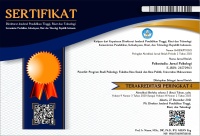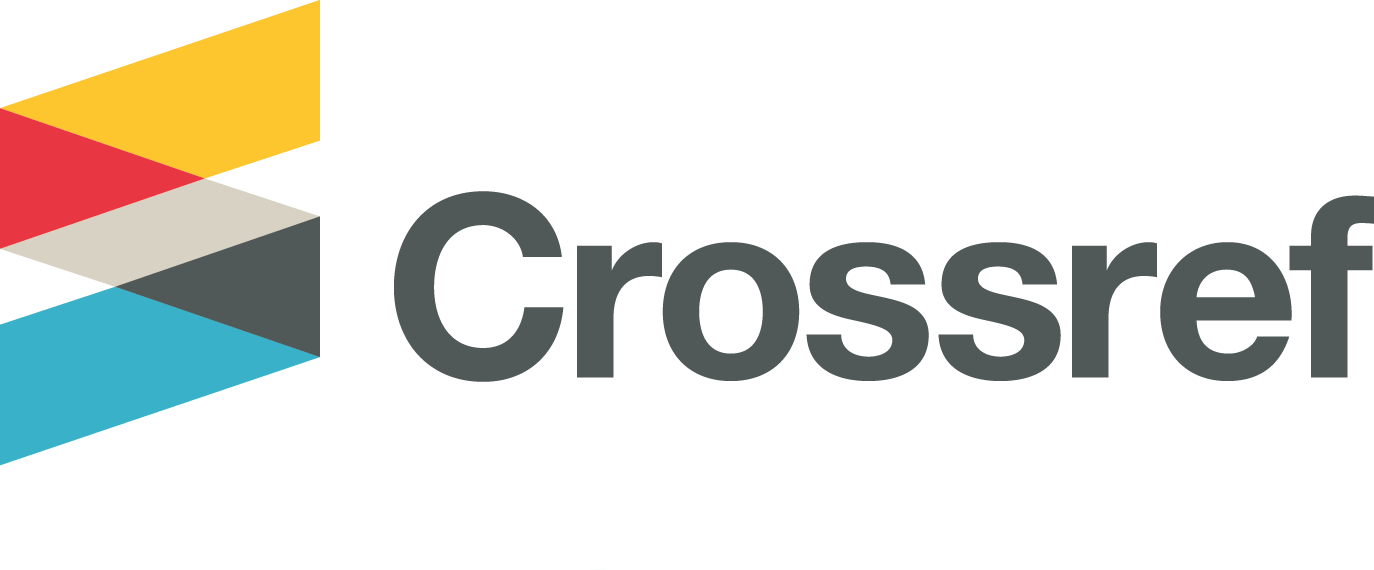Young Adults’ Help-Seeking Experiences in Dealing with Nonsuicidal Self-Injury
Abstract
Nonsuicidal self-injury (NSSI) is a common mental health issue found among young adults. This study explored the experiences of help-seeking among Indonesian young adults with NSSI, as well as the supporting and inhibiting factors in the process. The approach used in this study is qualitative with a phenomenological research design. NSSI assessments, semi-structured interviews, and photo elicitation techniques were conducted on three participants through purposive sampling with the criteria being aged 18-24 who were indicated to have previously engaged in NSSI. The results of the interpretative phenomenological analysis revealed two themes in the participants’ help-seeking experiences: experiences that initiate seeking help and personal and professional support. Factors influencing help-seeking behavior were also identified, including perceptions of NSSI, perceptions of helpers and received support, public stigma, and social construction. The implications of this research focus on mental health education and the development of mental health service options in addressing negative stigmas and issues related to NSSI.
Nonsuicidal self-injury (NSSI) merupakan isu kesehatan mental yang umum ditemui pada dewasa muda. Penelitian ini mengeksplorasi pengalaman mencari bantuan pada dewasa muda di Indonesia dengan NSSI, serta faktor pendukung dan penghambat dalam prosesnya. Pendekatan penelitian ini adalah kualitatif dengan desain penelitian fenomenologi. Dilakukan asesmen NSSI, wawancara semi terstruktur dan teknik photo elicitation pada tiga partisipan melalui purposive sampling dengan kriteria usia 18-24 tahun dan terindikasi pernah melakukan NSSI. Hasil interpretative phenomenological analysis menemukan dua tema dalam pengalaman partisipan mencari bantuan, yaitu: pengalaman yang menginisiasi mencari bantuan dan bantuan personal dan profesional. Ditemukan juga faktor yang memengaruhi perilaku mencari bantuan, berupa: persepsi terhadap NSSI, persepsi terhadap helper dan bantuan yang diterima, stigma publik, dan konstruksi sosial. Implikasi penelitian berfokus pada edukasi kesehatan mental serta pengembangan opsi layanan kesehatan mental dalam menghadapi isu dan stigma negatif terhadap NSSI.
Keywords
Full Text:
FULL TEXTReferences
Aguirre Velasco, A., Cruz, I. S. S., Billings, J., Jimenez, M., & Rowe, S. (2020). What are the barriers, facilitators and interventions targeting help-seeking behaviours for common mental health problems in adolescents? A systematic review. BMC Psychiatry, 20(1), 293. https://doi.org/10.1186/s12888-020-02659-0
Alshenqeeti, H. (2014). Interviewing as a Data Collection Method: A Critical Review. English Linguistics Research, 3(1). https://doi.org/10.5430/elr.v3n1p39
American Psychiatric Association. (2022). Diagnostic and Statistical Manual of Mental Disorders. American Psychiatric Association Publishing. https://doi.org/10.1176/appi.books.9780890425787
Arbuthnott, A. E., & Lewis, S. P. (2015). Parents of youth who self-injure: a review of the literature and implications for mental health professionals. Child and Adolescent Psychiatry and Mental Health, 9(1), 35. https://doi.org/10.1186/s13034-015-0066-3
Arinda, O. D., & Mansoer, W. W. D. (2020). NSSI (Nonsuicidal Self-Injury) pada Dewasa Muda di Jakarta: Studi fenomenologi interpretatif. Jurnal Psikologi Ulayat. https://doi.org/10.24854/jpu150
Banerjee, D., & Meheli, S. (2022). Revisiting Social Stigma in Non-suicidal Self-injury: A Narrative Review. Consortium Psychiatricum, 3(3), 6–19. https://doi.org/10.17816/CP196
Barker, G. (2007). Adolescents, social support and help-seeking behaviour: An international literature review and programme consultation with recommendations for action. World Health Organization.
Bond, K. S., Lyons, J. N., Cottrill, F. A., Sabo, A. V., Baillie, S. E., Rossetto, A., Kelly, L., Kelly, C. M., Reavley, N. J., Jorm, A. F., & Morgan, A. J. (2023). Evaluation of the Conversations about Non-Suicidal Self-Injury Mental Health First Aid Course: Effects on Knowledge, Stigmatising Attitudes, Confidence and Helping Behaviour. International Journal of Environmental Research and Public Health, 20(4), 3749. https://doi.org/10.3390/ijerph20043749
Borden, J. W., Clum, G. A., Broyles, S. E., & Watkins, P. L. (1988). Coping strategies and panic. Journal of Anxiety Disorders, 2(4), 339–352.
Boyes, M. E., Mah, M. A., & Hasking, P. (2023). Associations between Family Functioning, Emotion Regulation, Social Support, and Self-injury among Emerging Adult University Students. Journal of Child and Family Studies, 32(3), 846–857. https://doi.org/10.1007/s10826-022-02516-6
Briones-Buixassa, L., Alí, Í., Schmidt, C., Nicolaou, S., Pascual, J. C., Soler, J., & Vega, D. (2021). Predicting Non-Suicidal Self-Injury in Young Adults with and without Borderline Personality Disorder: a Multilevel Approach Combining Ecological Momentary Assessment and Self-Report Measures. Psychiatric Quarterly, 92(3), 1035–1054. https://doi.org/10.1007/s11126-020-09875-7
Campbell, S., Greenwood, M., Prior, S., Shearer, T., Walkem, K., Young, S., Bywaters, D., & Walker, K. (2020). Purposive sampling: complex or simple? Research case examples. Journal of Research in Nursing, 25(8), 652–661. https://doi.org/10.1177/1744987120927206
Creswell, J. W., & Poth, C. N. (2016). Qualitative inquiry and research design: Choosing among five approaches. Sage Publications.
Curtis, C., & Terry, M. (2024). The Effect of Gender on Identification and Interpretation of Non-Suicidal Self-Injury. Psychopathology, 57(1), 18–26. https://doi.org/10.1159/000531551
De Riggi, M. (2021). Response to nonsuicidal self-injury: The critical role of school leaders. McGill University.
Edwards-Bailey, L., Cartwright, T., Smyth, N., & Mackenzie, J.-M. (2023). A qualitative exploration of student self-harm and experiences of support-seeking within a UK university setting. Counselling Psychology Quarterly, 36(4), 638–662. https://doi.org/10.1080/09515070.2022.2146054
Elflein, J. (2023). Barriers to mental health services for U.S. college students in 2022-2023. Health, Pharma & Medtech.
Eriksen, M., Collins, S., Finocchio, B., & Oakley, J. (2020). Developing Students’ Coaching Ability Through Peer Coaching. Journal of Management Education, 44(1), 9–38. https://doi.org/10.1177/1052562919858645
Fortune, S., Sinclair, J., & Hawton, K. (2008). Help-seeking before and after episodes of self-harm: a descriptive study in school pupils in England. BMC Public Health, 8(1), 369. https://doi.org/10.1186/1471-2458-8-369
Fu, X., Yang, J., Liao, X., Lin, J., Peng, Y., Shen, Y., Ou, J., Li, Y., & Chen, R. (2020). Parents’ Attitudes Toward and Experience of Non-Suicidal Self-Injury in Adolescents: A Qualitative Study. Frontiers in Psychiatry, 11. https://doi.org/10.3389/fpsyt.2020.00651
Gerling, R. L. (2013). Non-suicidal self-injury: a training developed for school personnel. Professional Psychology Doctoral Projects, 24.
Ghinea, D., Edinger, A., Parzer, P., Koenig, J., Resch, F., & Kaess, M. (2020). Non-suicidal self-injury disorder as a stand-alone diagnosis in a consecutive help-seeking sample of adolescents. Journal of Affective Disorders, 274, 1122–1125. https://doi.org/10.1016/j.jad.2020.06.009
Glaw, X., Inder, K., Kable, A., & Hazelton, M. (2017). Visual Methodologies in Qualitative Research. International Journal of Qualitative Methods, 16(1), 160940691774821. https://doi.org/10.1177/1609406917748215
Guérin-Marion, C., Martin, J., Lafontaine, M.-F., & Bureau, J.-F. (2020). Invalidating Caregiving Environments, Specific Emotion Regulation Deficits, and Non-suicidal Self-injury. Child Psychiatry & Human Development, 51(1), 39–47. https://doi.org/10.1007/s10578-019-00908-2
Gulliver, A., Griffiths, K. M., & Christensen, H. (2010). Perceived barriers and facilitators to mental health help-seeking in young people: a systematic review. BMC Psychiatry, 10(1), 113. https://doi.org/10.1186/1471-244X-10-113
Gullotta, T. P., Plant, R. W., & Evans, M. A. (2015). Handbook of adolescent behavioural problems: Evidence-based approaches to prevention and treatment. Springer.
Hasking, P., Rees, C. S., Martin, G., & Quigley, J. (2015). What happens when you tell someone you self-injure? The effects of disclosing NSSI to adults and peers. BMC Public Health, 15(1), 1039. https://doi.org/10.1186/s12889-015-2383-0
Hewitt, O. M., Tomlin, A., & Waite, P. (2021). The experience of panic attacks in adolescents: an interpretative phenomenological analysis study. Emotional and Behavioural Difficulties, 26(3), 240–253. https://doi.org/10.1080/13632752.2021.1948742
Horowitz, M. J., & Reidbord, S. P. (2014). Memory, emotion, and response to trauma. In The handbook of emotion and memory. Psychology Press, 343–357.
Hughes, C. D., King, A. M., Kranzler, A., Fehling, K., Miller, A., Lindqvist, J., & Selby, E. A. (2019). Anxious and Overwhelming Affects and Repetitive Negative Thinking as Ecological Predictors of Self-Injurious Thoughts and Behaviors. Cognitive Therapy and Research, 43(1), 88–101. https://doi.org/10.1007/s10608-019-09996-9
Kaligis, F., Ismail, R. I., Wiguna, T., Prasetyo, S., Indriatmi, W., Gunardi, H., Pandia, V., & Magdalena, C. C. (2021). Mental Health Problems and Needs among Transitional-Age Youth in Indonesia. International Journal of Environmental Research and Public Health, 18(8), 4046. https://doi.org/10.3390/ijerph18084046
Kinasih, P. R. (2021). ‘Tilik’: A Study of Power Among Javanese Women Through Gossip. OKARA: Jurnal Bahasa Dan Sastra, 15(2), 221–234. https://doi.org/10.19105/ojbs.v15i2.5090
Lestari, P. M., Irawati, R. P., Pristiwati, R., & Fuadhiyah, U. (2021). Gossip among Javanese women in social interaction. Linguistica Antverpiensia, 1489–1502.
Lustig, S., Koenig, J., Resch, F., & Kaess, M. (2021). Help-seeking duration in adolescents with suicidal behavior and non-suicidal self-injury. Journal of Psychiatric Research, 140, 60–67. https://doi.org/10.1016/j.jpsychires.2021.05.037
Moustakas, C. (2009). Phenomenological research method. SAGE Publications.
Muehlenkamp, J., Brausch, A., Quigley, K., & Whitlock, J. (2013). Interpersonal Features and Functions of Nonsuicidal Self‐injury. Suicide and Life-Threatening Behavior, 43(1), 67–80. https://doi.org/10.1111/j.1943-278X.2012.00128.x
Park, Y., Mahdy, J. C., & Ammerman, B. A. (2021). How others respond to non‐suicidal self‐injury disclosure: A systematic review. Journal of Community & Applied Social Psychology, 31(1), 107–119. https://doi.org/10.1002/casp.2478
Prawira, B., Liem, A., Yulianto, J. E., & Han, J. (2023). The Associated Factors of Self-Harm and Suicide Ideation Among Chinese Indonesians During the COVID-19 Pandemic. International Perspectives in Psychology, 12(2), 85–95. https://doi.org/10.1027/2157-3891/a000070
Qomariah, N. , & Santi, D. E. (2021). Gambaran Kebermaknaan Hidup Pelaku Non-Suicidal Self-Injury (NSSI). Seminar Nasional Psikologi UM, 424–429.
Rahardjo, T. A., & Kusumiati, R. Y. E. (2023). Contribution of Emotional Maturity with Behavioral Tendencies of Self-Injury In Adolescents. Psikostudia : Jurnal Psikologi, 12(1), 99. https://doi.org/10.30872/psikostudia.v12i1.9311
Reid, K., Flowers, P., & Larkin, M. (2005). Exploring lived experience: An introduction to Interpretative Phenomenological Analysis. The Psychologist, 18(1), 20–23.
Rickwood, D., & Thomas. (2012). Conceptual measurement framework for help-seeking for mental health problems. Psychology Research and Behavior Management, 173. https://doi.org/10.2147/PRBM.S38707
Rosenrot, S. A., & Lewis, S. P. (2020). Barriers and responses to the disclosure of non-suicidal self-injury: a thematic analysis. Counselling Psychology Quarterly, 33(2), 121–141. https://doi.org/10.1080/09515070.2018.1489220
Rowe, S. L., French, R. S., Henderson, C., Ougrin, D., Slade, M., & Moran, P. (2014). Help-seeking behaviour and adolescent self-harm: A systematic review. Australian & New Zealand Journal of Psychiatry, 48(12), 1083–1095. https://doi.org/10.1177/0004867414555718
Salem, D. A., Reischl, T. M., Gallacher, F., & Randall, K. W. (2000). The Role of Referent and Expert Power in Mutual Help. American Journal of Community Psychology, 28(3), 303–324. https://doi.org/10.1023/A:1005101320639
Saraswati, P., & Winarsunu, T. (2022). Personal growth initiative profile on non-suicidal self-injury (NSSI). Proceeding of Biopsychosocial Issues, 129–130.
Simmons, M. B., Cartner, S., MacDonald, R., Whitson, S., Bailey, A., & Brown, E. (2023). The effectiveness of peer support from a person with lived experience of mental health challenges for young people with anxiety and depression: a systematic review. BMC Psychiatry, 23(1), 194. https://doi.org/10.1186/s12888-023-04578-2
Simone, A. C., Yu, S., & Hamza, C. A. (2023). Understanding experiences of disclosing and receiving disclosures of nonsuicidal self-injury amongst peers in university: A qualitative investigation. Counselling Psychology Quarterly, 36(4), 615–637. https://doi.org/10.1080/09515070.2022.2144807
Skehan, B., & Davis, M. (2017). Aligning Mental Health Treatments with the Developmental Stage and Needs of Late Adolescents and Young Adults. Child and Adolescent Psychiatric Clinics of North America, 26(2), 177–190. https://doi.org/10.1016/j.chc.2016.12.003
Staniland, L., Hasking, P., Lewis, S. P., Boyes, M., & Mirichlis, S. (2023). Crazy, Weak, and Incompetent: A Directed Content Analysis of Self-Injury Stigma Experiences. Deviant Behavior, 44(2), 278–295. https://doi.org/10.1080/01639625.2022.2038022
Swannell, S. V., Martin, G. E., Page, A., Hasking, P., & St John, N. J. (2014). Prevalence of Nonsuicidal Self‐Injury in Nonclinical Samples: Systematic Review, Meta‐Analysis and Meta‐Regression. Suicide and Life-Threatening Behavior, 44(3), 273–303. https://doi.org/10.1111/sltb.12070
Taylor, P. J., Jomar, K., Dhingra, K., Forrester, R., Shahmalak, U., & Dickson, J. M. (2018). A meta-analysis of the prevalence of different functions of non-suicidal self-injury. Journal of Affective Disorders, 227, 759–769. https://doi.org/10.1016/j.jad.2017.11.073
Taylor, S. E., Sherman, D. K., Kim, H. S., Jarcho, J., Takagi, K., & Dunagan, M. S. (2004). Culture and Social Support: Who Seeks It and Why? Journal of Personality and Social Psychology, 87(3), 354–362. https://doi.org/10.1037/0022-3514.87.3.354
Tresno, F., Ito, Y., & Mearns, J. (2012). Self-Injurious Behavior and Suicide Attempts Among Indonesian College Students. Death Studies, 36(7), 627–639. https://doi.org/10.1080/07481187.2011.604464
Walsh, B. W. (2006). Treating self-injury: a practical guide. . The Guilford Press.
Whitlock, J., Muehlenkamp, J., Eckenrode, J., Purington, A., Baral Abrams, G., Barreira, P., & Kress, V. (2013). Nonsuicidal Self-Injury as a Gateway to Suicide in Young Adults. Journal of Adolescent Health, 52(4), 486–492. https://doi.org/10.1016/j.jadohealth.2012.09.010
YouGov. (2019, June 26). A quarter of Indonesians have experienced suicidal thoughts. YouGov.
Zakaria, Z. Y. H., & Theresa, R. M. (2020). FAKTOR-FAKTOR YANG MEMENGARUHI PERILAKU NONSUICIDAL SELF-INJURY (NSSI) PADA REMAJA PUTRI. Journal of Psychological Science and Profession, 4(2), 85. https://doi.org/10.24198/jpsp.v4i2.26404
Zheng, S., Masuda, T., Matsunaga, M., Noguchi, Y., Ohtsubo, Y., Yamasue, H., & Ishii, K. (2021). Cultural differences in social support seeking: The mediating role of empathic concern. PLOS ONE, 16(12), e0262001. https://doi.org/10.1371/journal.pone.0262001
DOI: http://dx.doi.org/10.30872/psikostudia.v13i1.14878
Refbacks
- There are currently no refbacks.
Copyright (c) 2024 Cindy Julistya Siswanto & Meilani Sandjaja

This work is licensed under a Creative Commons Attribution-ShareAlike 4.0 International License.
Psikostudia: Jurnal Psikologi is indexed by :
PSIKOSTUDIA: Jurnal Psikologi Published by Faculty of Social and Political Siences, University of Mulawarman, Samarinda, East Kalimantan and This work is licensed under a Creative Commons Attribution-ShareAlike 4.0 International License.
_________________________________________
PSIKOSTUDIA: Jurnal Psikologi
Department of Psychology
Faculty of Social and Political Siences, University of Mulawarman
Jl. Muara Muntai Kampus Gn. Kelua Samarinda 75411
Phone: +62 813 35350368
E-Mail: psikostudia@fisip.unmul.ac.id




















